Listing
Course Catalog
Our curriculum combines a proprietary History/Geography, Science, and Language Arts program with a range of math options, including Math-U-See, Saxon, Singapore, and RightStart, to ensure you have everything you need for an entire school year.
- History
- Level A (Ages: 5-7)
- Level B (Ages: 6-8)
- Level C (Ages 7-9)
- Level D (Ages 8-11)
- Level E (Ages 9 - 11)
- Level F (Ages 10 - 13)
- Level G (Ages 11 - 13)
- Level H (Ages 12 - 14)
- Level I (Ages 13 - 15)
- Science
- Level A (Ages: 5-7)
- Level B (Ages 6-8)
- Level C (Ages 7-9)
- Level D (Ages 8-11)
- Level E (Ages 9-12)
- Level F (Ages 10-13)
- Level G (Ages 11-13)
- Level H (Ages 12-14)
- Language Arts
- Level K
- Level 1
- Level 2
- Level 3
- Level 4
- Level D
- Level E
- Level F
- Level G
- Level H
- Level I
- Math
- Math-U-See
- RightStart Math
- Saxon Math
- Singapore Math
Reading with History A

Description:
Reading with History A is a social studies course that introduces students to new and interesting people as they travel to distant lands and long-ago times. Study Ancient Egypt, Rome, knights and castles, geography, climates and much more. Engaging questions connect them to the various people and places to be discovered. Kindergarteners learn about the social studies disciplines (history, geography, civics and government, and economics) through the lens of “Myself and Others” as the various cultures and regions are discussed.Reading with History A PACKAGE:
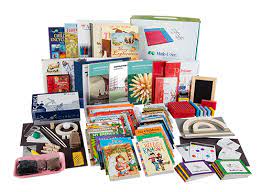
Includes:
BookShark Virtual Platform
BookShark Instructor's Guide
History Books
Readers
Read Alouds
Binder, Tabs, Timeline Book, Markers, and Markable Map
Reading with History B
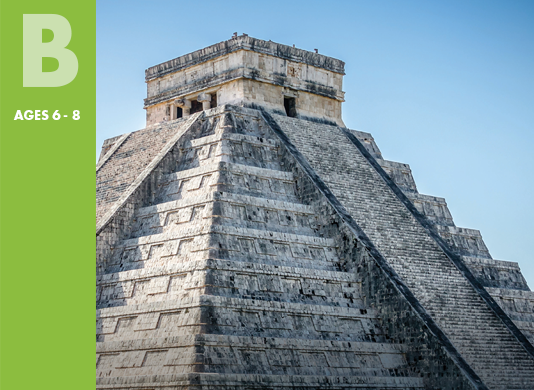
Description:
Reading with History B is a social studies course that takes students through the first half of a two-year sweep of World History, from early civilizations to the Fall of the Roman Empire. Literature-rich learning makes this journey a delight! Students see how different people groups live, build homes, talk, eat and dress. The fascinating pictures in The Usborne Book of World History gives a broad look at key ancient civilizations. The entertaining Time Traveler book provides an in-depth look at everyday life long ago and gives them a real sense of what it was like to live in Ancient Egypt and Ancient Rome. As students move through these three books, they also use a timeline to map history, explore the Great Wall of China and do fun hands-on activities. Students continue to explore the social studies disciplines of history, geography, civics and government, and economics through an integrated approach with discussions within the context of their immediate surroundings of school and family.Reading with History B PACKAGE:
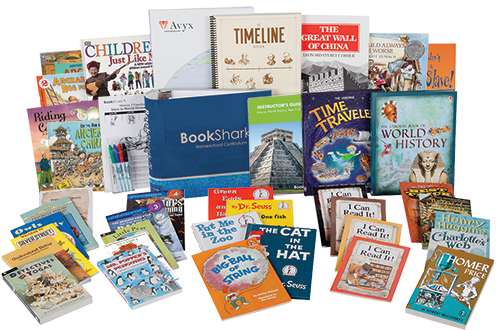
Includes:
BookShark Virtual Platform
BookShark Instructor's Guide
History Books
Readers
Read-Alouds
Binder, Tabs, Timeline Book, Markers, and Markable Map
Reading with History C

Description:
Reading with History C is a social studies course that takes students through the second half of a two-year sweep of World History, from the fall of Rome through the Middle Ages, the Renaissance, Asian dynasties and the Industrial Revolution to modern global history. Students read about adventure with Vikings, medieval knights, Robin Hood, mighty stallions, astronauts and more! As students see the flow of world history--the rise and fall of civilizations--they get a big-picture look at what's gone into creating history. That, in turn, helps them understand how we live today. Students continue the integrative approach to social studies through the context of the local community and are introduced to a social environment larger than their immediate surroundings.Reading with History C PACKAGE:
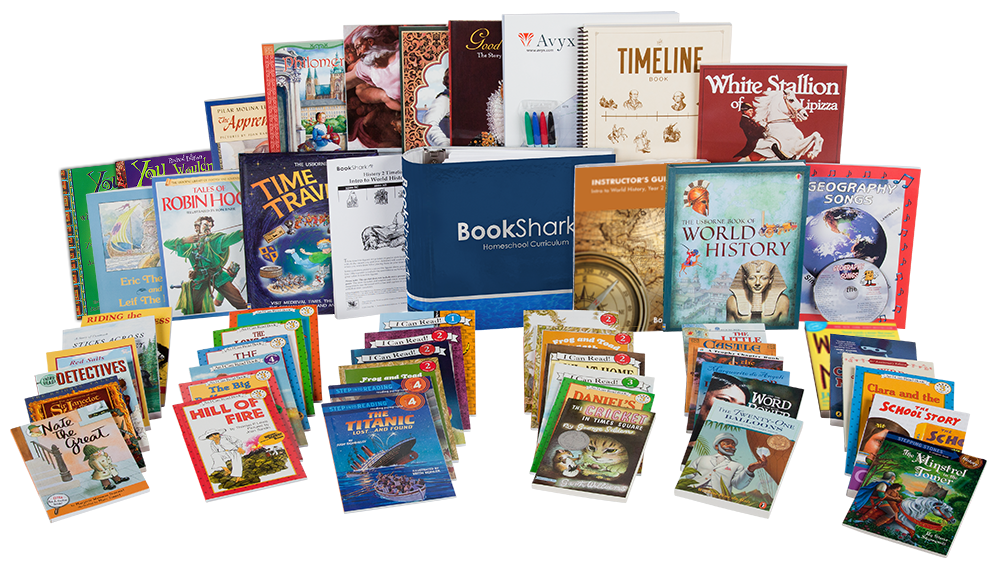
Includes:
BookShark Virtual Platform
BookShark Instructor's Guide
History Books
Readers
Read-Alouds
Binder, Tabs, Timeline Book, Markers, and Markable Map
Reading with History D
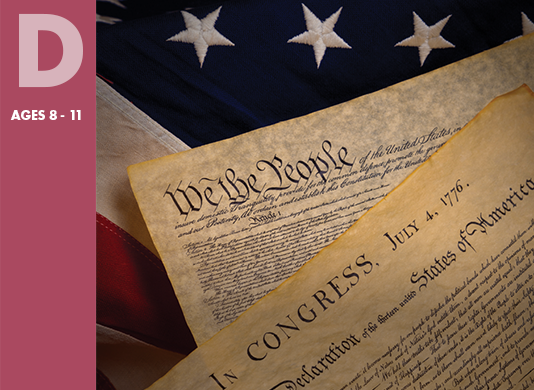
Description:
Reading with History D is a social studies course that takes students through the first half of the introduction to American History and journeys them through American history from before the Spanish conquistadors through the 1850s. Students read about the innovative spirit that characterized early American history. They meet Incans, Aztecs and Mayans, sail with Columbus, journey with Lewis and Clark, and invent with Benjamin Franklin! Students explore the social studies disciplines of history, geography, civics and government, and economics through the context of this time frame as well as the incorporation of supplemental materials for their state and local areas. There’s an option to add the state lap book to cover topics specific to their state’s economy and way of life. There’s also the option to add an additional supplement to cover components of state and local government.Reading with History D PACKAGE:
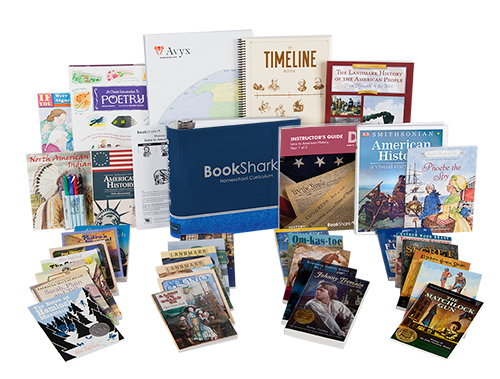
Includes:
BookShark Virtual Platform
BookShark Instructor's Guide
History Books
Readers
Read-Alouds
Binder, Tabs, Timeline Book, Markers, and Markable Map
Reading with History E

Description:
Reading with History E is a social studies course that takes students through the second half of the introduction to American History and experiences America's history from the 1850s on to current times. Students get to know heroes like Abraham Lincoln, Eleanor Roosevelt and the Wright brothers. They find out how Americans' unique perspective--our egalitarianism, our desire for change, and our "can-do" spirit--contributed to inventions such as ready-to-wear clothing, department stores and skyscrapers. Students discover why time zones and "fast food" came into existence. They examine how mass immigration, women's suffrage, the labor movement and the GreatDepression impacted the social, political, and economic climate of the country and discuss how racism has influenced life for individuals and the entire nation throughout the years. Using the context of the state of Michigan post statehood and the United States, 4th grade students learn significant social studies concepts within an increasingly complex social environment. They examine fundamental concepts in geography, civics and government, and economics organized by topic, region, or issue.Reading with History E PACKAGE:
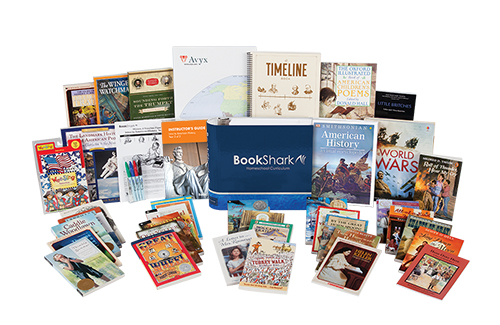
Includes:
BookShark Virtual Platform
BookShark Instructor's Guide
History Books
Readers
Read-Alouds
Binder, Tabs, Timeline Book, Markers, and Markable Map
Reading with History F

Description:
Reading with History F is a middle school social studies course that takes students to regions of North Africa, the Middle East and Asia. Students read about the people and culture of China, Korea, Japan, Russia, Southeast Asia, Vietnam, India, the Middle East, Israel, Saudi Arabia, Africa, the Pacific Islands, New Zealand, Australia, and Antarctica. As they study these people and regions, they look at the geography in spatial terms and physical/human systems, environment/society and global Issues. They also cover civics and government by looking at the purpose, structure and functions of government and discuss their relationship to the United States. They explore the economic element of these regions and look at the market Economy, the National Economy, and the International Economy as well as civic participation with these.Reading with History F PACKAGE:
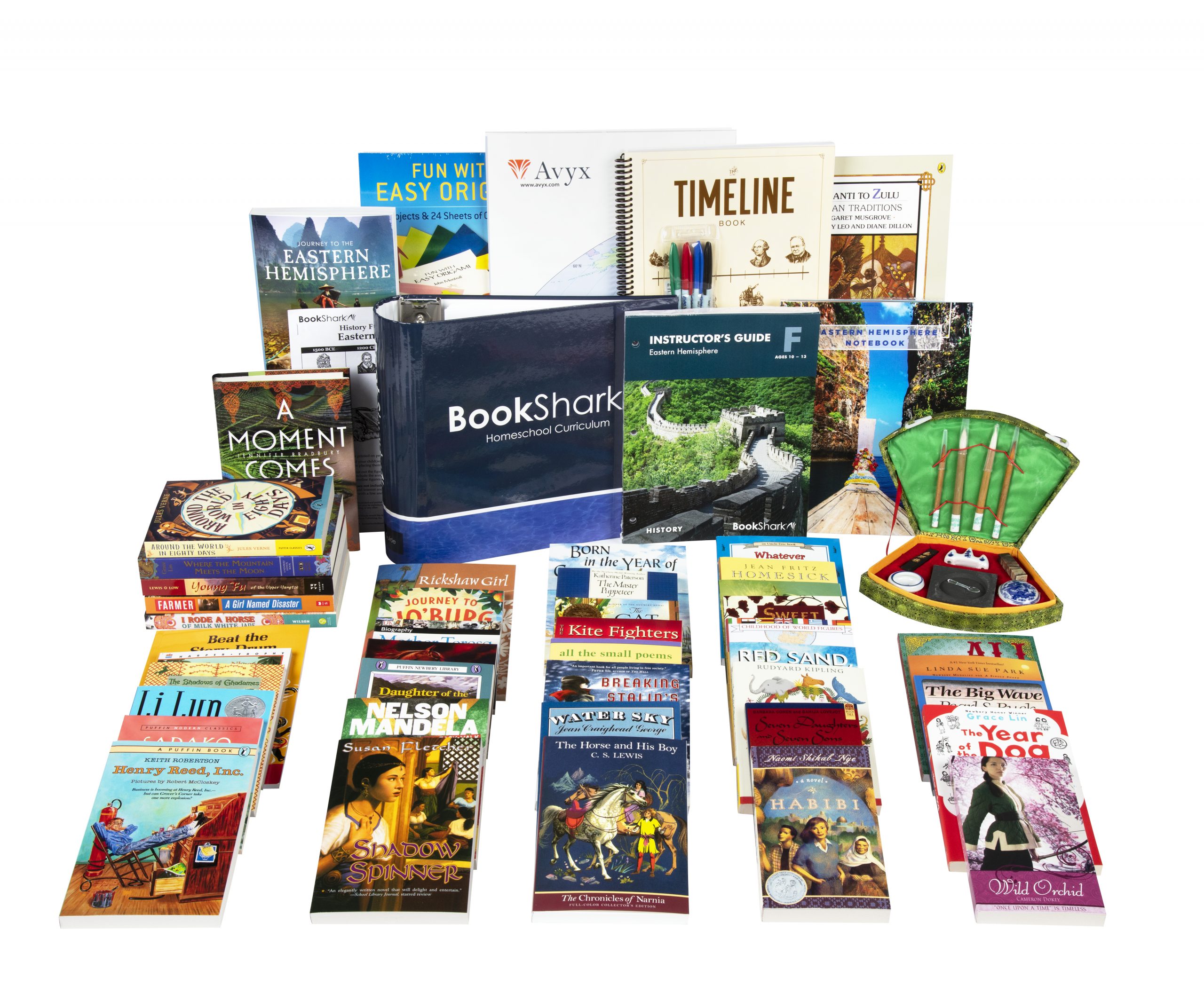
Includes:
BookShark Virtual Platform
BookShark Instructor's Guide
History Books
Readers
Read-Alouds
Binder, Tabs, Timeline Book, Markers, and Markable Map
Reading with History G

Description:
Year one of middle school World History takes students through the first half of a two-year sweep of World History, through Ancient Mesopotamia, Egypt, Greek culture, Ancient Rome and much more. Students read the first two volumes of the Story of the World books “Ancient Times” and “The Middle Ages” that cover a gripping story-based trek through history. Students mark events on a timeline as they read about the different locations and people as well as mark locations on their map. As students cover the world history content, they will discuss global and interregional perspectives and interactions between these different regions and eras.Reading with History G PACKAGE:

Includes:
BookShark Virtual Platform
BookShark Instructor's Guide
History Books
Readers
Read-Alouds
Binder, Tabs, Timeline Book, Markers, and Markable Map
Reading with History H

Description:
Year two of World History for middle schoolers takes students through the second half of a two-year sweep of World History from around the 17th Century to around the 1900’s. Students read about events like colonialism and the rise and fall of the Asian dynasties. The History books, Read-Alouds, Readers and Language Arts all intertwine for a cohesive, reinforced learning experience. Students read the final two volumes of The Story of the World “Early Modern Times” and “Modern Age” which provide a story-based trek through history. The critically acclaimed Kingfisher History Encyclopedia, organized into 10 historical eras, is their one-stop research source and perfect companion to their study of World History. Timeline Figures are included to help your child map the flow of History as well as a map that they mark locations as they study different regions. As students cover the world history content, they will discuss global and interregional perspectives and interactions between these different regions and eras.Reading with History H PACKAGE:
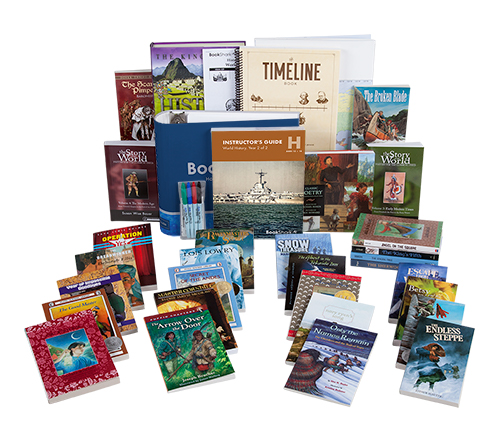
Includes:
BookShark Virtual Platform
BookShark Instructor's Guide
History Books
Readers
Read-Alouds
Binder, Tabs, Timeline Book, Markers, and Markable Map
Reading with History I

Description:
American History for middle school provides the foundation to the story of our nation. They examine events, people and debates that have molded the United States. They fill in the timeline and map as they cover the different regions and people. Since this is a literature based course, students read about Columbus, Sacajawea, the Freedom walkers and more as they study the events that helped shape our nation. As students cover the American History content, they will discuss the historical and geographical knowledge, perspective, analysis and interpretation as it relates to the different eras within our country as well as the development of industrial, urban, and global United States. They also discuss the geography of these areas in terms of spatial terms, human systems, environment and society. They cover civic participation by identifying and analyzing public issues through engaging discussions within these regions and time periods.Reading with History I PACKAGE:

Includes:
BookShark Virtual Platform
BookShark Instructor's Guide
History Books
Readers
Read-Alouds
Binder, Tabs, Timeline Book, Markers, and Markable Map
Science A

Description:
In Science A, students will learn about wildlife and ecosystems; weather patterns and the purpose of weather forecasting; and simple machines and physics. The literature includes eleven engaging, easy to read and easy to follow books, with vivid, full-color illustrations about life, weather, and an introduction to STEM topics, like engineering. Topics will incorporate Reptiles, Rainforests, Bees/Wasps, From Seed to Plant, clouds and hurricanes. It also includes some non-fiction books for students to explore additional topics and a biography about a Nobel Prize winner. Students will engage in activities including building an ant tunnel, making chocolate from cocoa, designing a boat, and more!Science A PACKAGE:
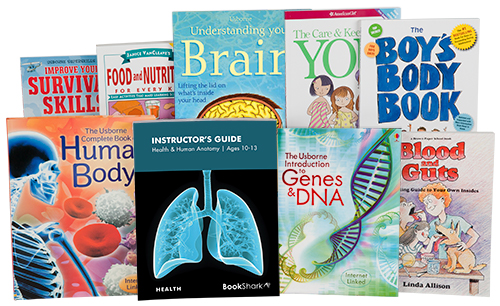
Includes:
BookShark Virtual Seat
BookShark Science Instructor's Guide
BookShark Science Experiment Book
Literature
Science Experiment Kit
Science B

Description:
In Science B, students will learn about light and sound waves, animal life and survival, the solar system, and engineering design. The literature includes an illustrated children’s encyclopedia that covers geology, the human body, animal life, and technology. In addition, students will read books covering topics of light waves, sound waves, and how to stave off illness. They will enjoy adventures through the body and outer space while reading books from The Magic School Bus series as well as an interactive, Lift-the-Flap Engineering book and a biography on Louis Pasteur. Experiments range from: constructing and testing an air balloon rocket, building a floating boat, assembling a bird’s nest, and much more!Science B PACKAGE:

Includes:
BookShark Virtual Seat
BookShark Science Instructor's Guide
BookShark Science Experiment Book
Literature
Science Experiment Kit
Science C

Description:
In Science C, students will learn about the interdependent relationships of plants and animals in ecosystems, explore what the world is made of, and examine the water cycle. The literature includes an illustrated resource book on animals and their habitats, picture books on plants, earth, and what the earth is made of, and a story from the Magic School Bus series. Students will also read an inspiring biography about Marie Curie, then venture into chemistry while reading the interactive, Lift-the-Flap Periodic Table book. Experiments range from: forming a cave with water, constructing a building to survive an earthquake, discovering first-hand why animals pick things up with their mouths instead of their paws, and much more!Science C PACKAGE:

Includes:
BookShark Virtual Seat
BookShark Science Instructor's Guide
BookShark Science Experiment Book
Literature
Science Experiment Kit
Science D
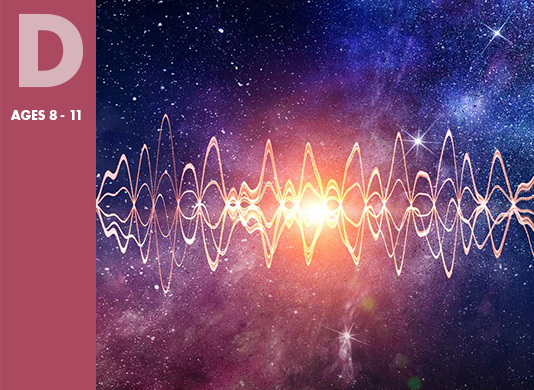
Description:
In Science D, students will learn about forces and interactions, life systems and cycles, weather and climate, and engineering design. The literature includes two insightful and engaging resource books. “The Did You Know?” Science book focuses on the needs of living things, the human body, and meteorology, while the “Usborne Encyclopedia of Seas and Ocean’s” book focuses on the ecosystems found in our ocean depths. Students will read books on fossils, magnets, genetic traits, and weather. The literature is complemented by an entertaining stories like the Magic School Bus squeezing through power lines, a true story about wolves restoring an entire ecosystem, a captivating introduction to robots, and a biography on the electrical wizard Nikola Tesla. Experiments range from: constructing a roof that can withstand a hurricane, creating an electrical current to light up a battery, building a robot powered by a motor, and more!Science D PACKAGE:
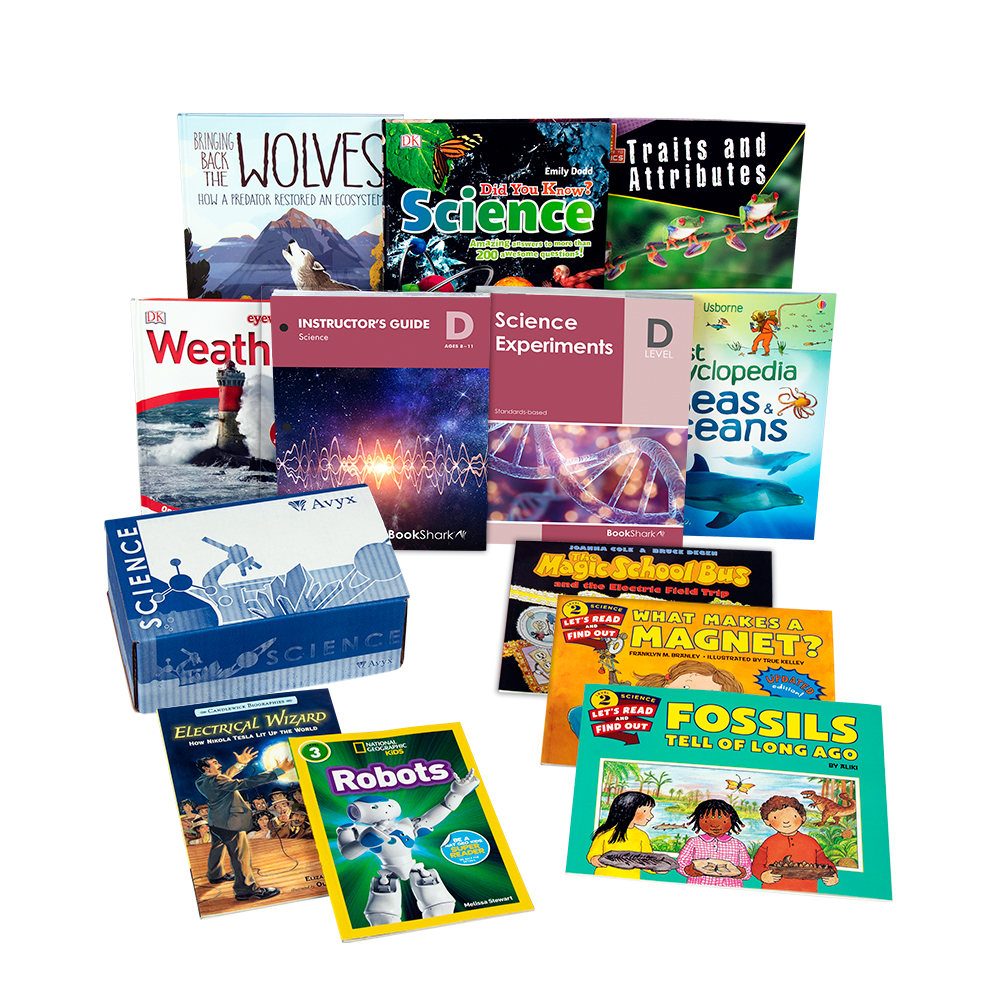
Includes:
BookShark Virtual Seat
BookShark Science Instructor's Guide
BookShark Science Experiment Book
Literature
Science Experiment Kit
Science E

Description:
In Science E, students will learn about energy; earth’s systems, including rock formations, tectonic plates, and natural hazards; the properties of waves; and physical characteristics of living things. The literature includes three Usborne resource books, starting with a student friendly dictionary that explains nearly every concept of basic science as well as a book that focus on the abilities certain animals develop to survive and an in-depth look at planet earth. Students will also read illustrated books about waves and energy, an interactive workbook that covers computer coding, and a biography about a famous Hollywood inventor. Experiments range from: simulating animal nerve connections with an electrical current, building a methane gas collection system, creating an electromagnet, and many more!Science E PACKAGE:
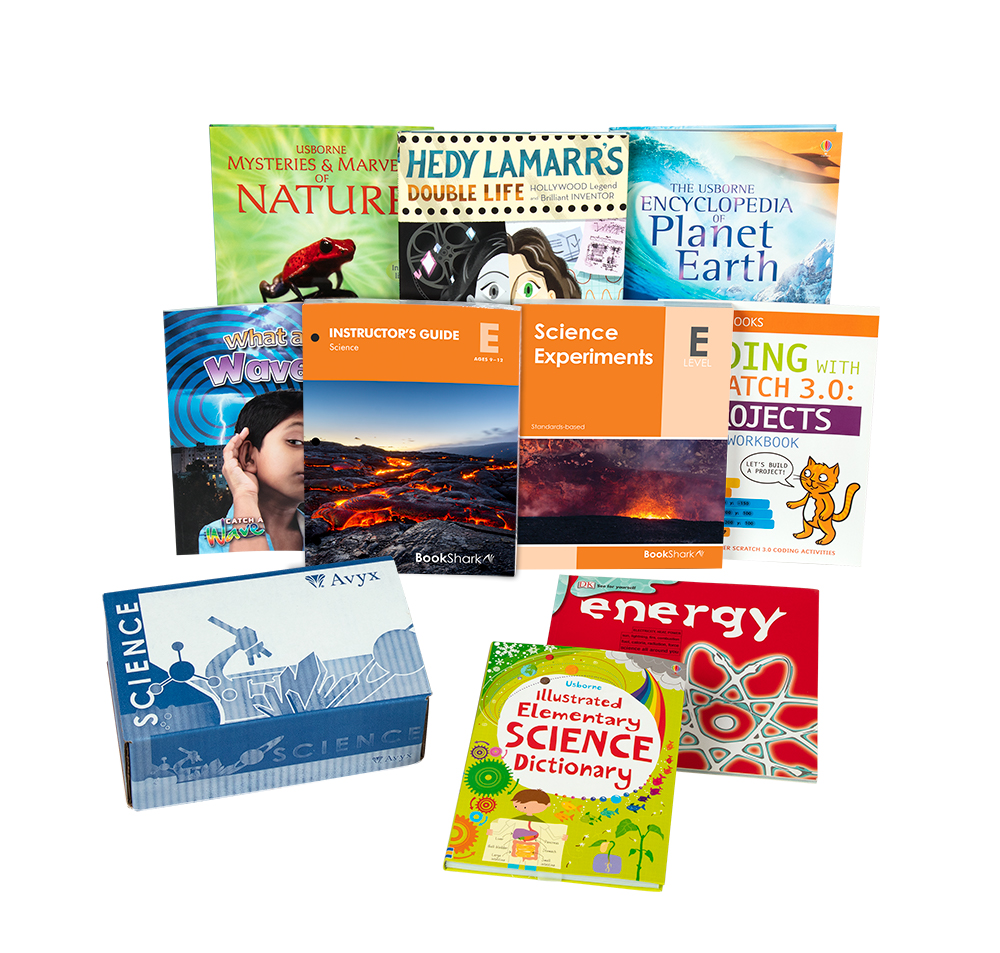
Includes:
BookShark Virtual Seat
BookShark Science Instructor's Guide
BookShark Science Experiment Book
Literature
Science Experiment Kit
Science F

Description:
In Earth and Space Science, students will dive deep into the application of science, learning about stars and the solar system, human impact on earth’s materials and systems, matter and energy, and properties of matter. The literature starts with How to Be Good at Science: Technology, and Engineering, a comprehensive showcase of science and technology. The book is packed with illustrations explaining everything from atoms and microchips to the multi-layered structure of the earth. Students will also read a spectacular book on space, a guide that explains the water industry, and a biography about the award-winning author and marine biologist Rachel Carson. Experiments range from: engineering a catapult, constructing an articulating hand, making plastic from corn, and many more!Science F PACKAGE:

Includes:
BookShark Virtual Seat
BookShark Science Instructor's Guide
BookShark Science Experiment Book
Literature
Science Experiment Kit
Science G
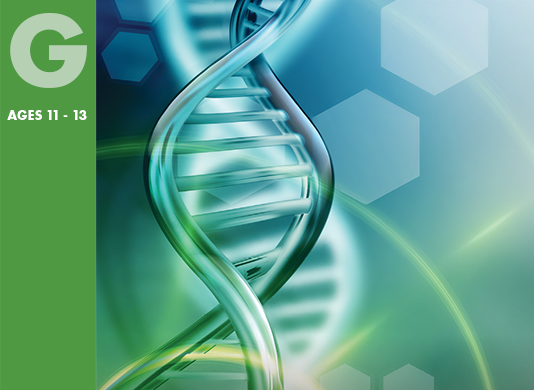
Description:
Physical Science will cover foundational concepts within chemistry as well as expand into physics and biology to build a wide range of knowledge in these fields of study. In the chemistry portion, students will complete experiments like how to make sugar crystals or test foods for sugar. They will also learn the periodic table and how the structure of substances are affected by electrical forces between particles as well as how the composition of the nucleus of an atom can change. They will look at chemical reactions and how atoms are conserved during a chemical reaction. They will conduct chemistry experiments as they complete the TOPS: Analysis book and the TOPS: cohesion/adhesion book which includes chemical analysis and learning how to separate known and unknown substances as well as how chromatography works, why oil slicks disperse on water with the addition of soap and why soap films have those patterns on their surfaces. Students will touch on basic physics and biology concepts as well in order to lay the groundwork for these fields of study and cover key science topics including electricity, the periodic table and the human body.Science G PACKAGE:

Includes:
BookShark Virtual Seat
BookShark Science Instructor's Guide
Literature
Science Experiment Kit
Science H

Description:
Environmental science covers topics of conservation, robotics and technology. Students explore energy, conservation, robotics, the human brain and technology through projects and experiments to inspire interest in these fascinating fields of study. They will gain perspective of today’s popular career markets like robotics, conservation, energy, engineering and technology as they look at topics like solar robots, windmills and dams. They will Learn about the history and science of the world's energy sources, from nonrenewable fossil fuels such as oil and natural gas to renewable sources such as solar and wind. Students will look at the interdependent relationships in ecosystems by discussing factors affecting biodiversity and populations as well as how natural selection leads to adaptation of populations. They will also look at how changes in environmental conditions may result in an increase of some species, the emergence of new species and the extinction of other species. Students will learn about factors that affect human sustainability and how the availability of natural resources, occurrence of natural hazards and climate change have influenced human activity. Students Learn about the industrial revolution and the dynamic individuals and revolutionary innovations that impacted our lives, and changed the course of the modern world. In covering engineering design, students will apply problem solving and critical thinking to solve a real world problem with numerous criteria and constraints on interactions within and between systems relevant to the problem and look at waterways and barriers like the ancient aqueducts and the Hoover Dam.Science H PACKAGE:
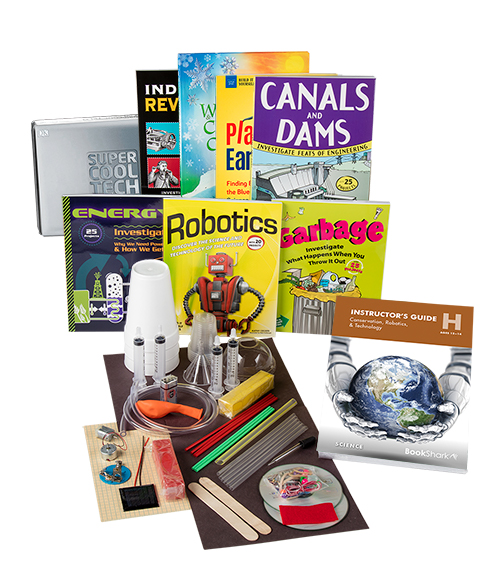
Includes:
BookShark Virtual Seat
BookShark Science Instructor's Guide
Literature
Science Experiment Kit
Language Arts K

Description:
Language Arts K offers basic exercises in figure-ground discrimination and top-to-bottom, left-to-right sequencing. Perfect for students ready to learn the alphabet as letters and primary sounds are introduced. There is a “letter/word recognition”, a “language/phonics” and a “writing skills” activity incorporated into each week’s lessons. Students encounter spelling words tied to phonics principles as well as complete assignments and activities to teach phonics, spelling, creative expression, and writing mechanics. Covers concepts for phonics, spelling, copywork, and creative expression/writing. With the phonics portion of the instruction, they will learn letter names and sounds as well as spelling and identifying sight words. They will also begin to learn how to express themselves and their thoughts in writing through imaginative and narrative writing. Reading skills will be reinforced through vocabulary development, story sequencing, comprehension and recollection with a variety of genres of stories (narrative, poetry and fables).Includes:
BookShark Virtual Seat
BookShark LA Instructor's Guide
Language Arts 1

Description:
Language Arts 1 focuses on developing reading, writing, spelling, speaking, and listening skills. Designed for students who have just begun to master three-letter short-vowel words. This level helps a student move to advanced short words and short chapter books. Students encounter spelling words tied to phonics principles as well as begin to understand the spoken and written language.. They use resources like letter bingo and blending games to work on skills that help them become an emergent reader. Daily experience and practice are the keys to this well-paced schedule of connected writing activities. This level will lay a foundation for the necessary basic writing skills while reinforcing what they learn from the books read together. They will learn about hard and soft sounds as well as become familiar with identifying consonants in the beginning, middle and end of words. Examples of phonics concepts covered are: initial sounds, short and long vowel sounds, blends, digraphs, rhyming and plurals. Some of the reading concepts covered are: letter recognition, sight words and forming words and writing concepts covered are: capitalization, dialog, writing mechanics, vocabulary, poetry and imaginative/narrative writing.Includes:
BookShark Virtual Seat
BookShark LA Instructor's Guide
Language Arts 2

Description:
Language Arts 2 central concepts are reading, writing, spelling, speaking, and listening. Designed for students who can decode most words but are still working toward proficiency in reading. It helps students organize their thoughts, construct basic sentences and write simple paragraphs. Language Arts 2 provides your student all the tools to help form and organize their thoughts, construct basic sentences and write simple paragraphs. Subjects covered include phonics, spelling, writing mechanics and creative expression. Students encounter spelling words tied to phonics principles as well as learn hundreds of new words while they build reading, writing, and thinking skills. As they read in context, apply meanings in different situations, and answer comprehension questions using complete sentences, they make these words their own. The phonics portion of the instruction covers systematic phonics and spelling rules, exercises that force children to think through the spelling of a word and comprehend what they are reading. Examples of phonics concepts covered are: syllables, suffixes, compound words, rhyming, alphabetizing and vowel sounds. Some of the writing concepts covered are: sentences, word order, punctuation, proper nouns/common nouns as well as descriptive words, dialog, parts of a story and the use of different styles of writing (narrative, descriptive and persuasive).Includes:
BookShark Virtual Seat
BookShark LA Instructor's Guide
Language Arts 3
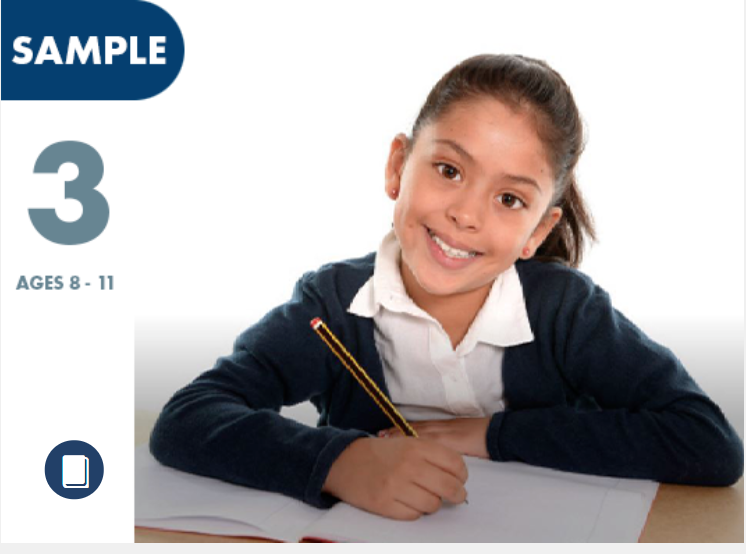
Description:
Language Arts 3 focuses on expanding students’ reading, writing, spelling, speaking, and listening skills as it moves through grammar, writing mechanics, research writing and creative expression. Students encounter spelling words tied to phonics principles. Ideal for students who are ready for more advanced reading practice as books featured have a controlled vocabulary and include stories that students will enjoy like detective stories, historical fiction and heartwarming adventures. Students will recognize and imitate good writing through dictation exercises, explore various writing styles through fun and diverse writing assignments and solidify their natural grasp of grammar. It builds on the concepts established in forming and organizing their thoughts, constructing basic sentences and writing simple paragraphs. The masterfully written, adventure-filled stories help cement the transition from "learning to read" to "reading to learn." Examples of writing concepts covered are: basic rules of sentences, nouns, adjectives, homophones, sentence fluency, writing mechanics and quotations. They will move through the writing process with a variety of genres of writing: narrative, descriptive, imaginative, persuasive, compare/contrast, research and poetry.Includes:
BookShark Virtual Seat
BookShark LA Instructor's Guide
Language Arts 4

Description:
Language Arts 4 focuses on grammar, writing mechanics, research writing, creative expression and written communication skills. Excellent for students able to read independently and includes stories that your student will enjoy to continue to develop a love of books and reading. Students encounter spelling words tied to phonics principles. Students will recognize and imitate good writing through dictation exercises, explore various writing styles through fun and diverse writing assignments and solidify their natural grasp of grammar. Parts of speech covered are nouns, pronouns, adjectives, verbs, prepositions, conjunctions. They will also explore the usage of phrases and clauses within sentences. There will be a focus on spelling rules, quotation marks and plurals. Writing concepts will cover narrative, character description, poetry, transition words, supporting details, research, combining sentences, retelling a story, scripts, facts/opinions and book review.Includes:
BookShark Virtual Seat
BookShark LA Instructor's Guide
Level D Language Arts

Description:
Language Arts D builds on concepts in grammar, writing mechanics, research writing and creative expression. Their writing style will expand as they learn about higher-level techniques like similes, metaphors and hyperbole. Students will recognize and imitate good writing through dictation exercises which will sharpen their ability to recognize and imitate good writing. They will explore various writing styles, solidify their natural grasp of grammar and stretch their imagination and refine communication skills through creative writing. A more advanced understanding of Parts of speech will be covered ie: nouns, pronouns, adjectives, verbs, prepositions, conjunctions. Writing mechanics like hyphens, commas, semicolons, quotation marks, parenthesis, apostrophes and capitalization will be emphasized. They will also expand their knowledge of types of sentences as well as abbreviations, acronyms and initialisms. The writing instruction will explore the purpose of writing and give them opportunities to construct observatory, persuasive, narrative, poetry and informational along with concepts of character development, storytelling, foreshadowing, research/revising, cause/effect, summarizing and honing in on the steps of the writing process.Includes:
BookShark Virtual Seat
BookShark LA Instructor's Guide
Level E Language Arts

Description:
Language Arts E begins to build on the foundation laid in the earlier grades and move the learner into more of an application stage of the grammar and reading strategies that had been covered in earlier levels while still allowing for writing strategies to be expanded on. Grammar will begin to develop with a fuller concept of how the different parts of speech interact within a sentence and serve different purposes within a variety of contexts. Some of the grammar topics are nouns, pronouns, adjectives, adverbs, antecedents, verbs, prepositional phrases, clauses and conjunctions. It will dive deeper into the sentence structure and building blocks of sentences. Some of the mechanics covered are commas, end punctuation, hyphens, colons, and capitalization. Writing concepts covered: point of view, topic sentences, transitions, symbolism, literary analysis, They also begin to delve into the design of plot structure and look at rising action and resolution. They dig deeper into pre writing strategies with brainstorming and the use of note cards and designing a well written thesis. They also work on writing better introductions and conclusions along with analyzing tone and voice.Includes:
BookShark Virtual Seat
BookShark LA Instructor's Guide
Level F Language Arts

Description:
Language Arts F builds on concepts in grammar, writing mechanics, research writing and creative expression. Their writing style will expand as they learn about higher-level techniques like similes, metaphors and hyperbole. Students will recognize and imitate good writing through dictation exercises which will sharpen their ability to recognize and imitate good writing. They will explore various writing styles, solidify their natural grasp of grammar and stretch their imagination and refine communication skills through creative writing. A more advanced understanding of Parts of speech will be covered ie: nouns, pronouns, adjectives, verbs, prepositions, conjunctions. Writing mechanics like hyphens, commas, semicolons, quotation marks, parenthesis, apostrophes and capitalization will be emphasized. They will also expand their knowledge of types of sentences as well as abbreviations, acronyms and initialisms. The writing instruction will explore the purpose of writing and give them opportunities to construct observatory, persuasive, narrative, poetry and informational along with concepts of character development, storytelling, foreshadowing, research/revising, cause/effect, summarizing and honing in on the steps of the writing process.Includes:
BookShark Virtual Seat
BookShark LA Instructor's Guide
Level G Language Arts

Description:
Language Arts G corresponds closely with the literature, offering a complete writing program that develops critical thinking skills, literary analysis, and creative writing. They expand their knowledge of grammar as they learn about more types of nouns, pronouns, adjectives, adverbs and verbs. They continue to build on mechanics and practice the application of commas, apostrophes, parenthesis, hyphens/dashes, colons/semicolons and writing numbers. Students explore the basic building blocks of sentences in order to understand and be able to identify sentence structure. They go over commonly misused words as well as how to write titles. Instruction covers how to compose various writing assignments: narrative, argumentative, expository, persuasive and descriptive as well as a 4 week research project and newspaper writing. Each of these writings have a coordinating series of evaluation questions to analyze the quality of the student’s finished work. They look at point of view, symbolism, plot, imagery, and tone as they expand their knowledge of writing as well as read and analyze poetry, biographies, fairytales, newspaper articles and even a peace treaty. They delve into character analysis and character study as well as foreshadowing and summarizing as they read a variety of literature.Includes:
BookShark Virtual Seat
BookShark LA Instructor's Guide
Level H Language Arts

Description:
Language Arts H offers the balance of creative writing, grammar and writing mechanics and has them digging deeper in the “why’ of grammar and writing - how the parts of speech and writing techniques enhance written and spoken communication. While critically reading fiction, poetry, drama, and literary nonfiction, students will master comprehension and literary-analysis strategies. In covering the parts of speech, they will cover the different types of nouns, verbs, adjectives and adverbs as well as subject verb agreement and identifying different types of phrases/clauses. Their writing will begin to focus more on literary analysis and reflection. They will move through the steps of developing a research paper. They will also explore different writings like newspaper, third person narratives, oral communications and creative writing.Includes:
BookShark Virtual Seat
BookShark LA Instructor's Guide
Language Arts I

Description:
Language Arts I corresponds closely with the literature, offering a complete writing program that develops critical thinking skills and creative writing. Instruction covers how to compose various writing assignments: narrative, argumentative, expository, persuasive, compare/contrast and descriptive as well as a 4 week research project, a timed essay and newspaper writing. Each of these writings have a coordinating series of evaluation questions to analyze the quality of the student’s finished work. They delve into character analysis and character study as well as foreshadowing and summarizing as they read a variety of literature. This level reinforces literary analysis and reading comprehension skills with quality literature.Includes:
BookShark Virtual Seat
BookShark LA Instructor's Guide
Math-U-See Primer
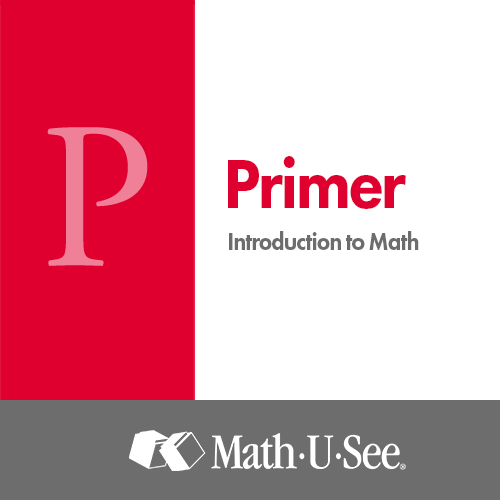
Description:
In the Primer level, students will learn addition/subtraction, basic counting, skip counting, recognizing & drawing rectangles, squares, and circles, measuring length, introducing halves and fourths, counting by 2s, 5s, 10s, and 100s, reading, writing & interpreting word problems and telling time. They will be introduced to the manipulative block system as an introduction to “doing math. Concepts presented will incorporate counting objects and developing numeracy, understanding place value, recognizing number names and symbols, reading and writing numerals, understanding addition and subtraction with concrete and representational models, and understanding math symbols.Includes:
BookShark Virtual Seat
Math-U-See Instruction Pack
Math-U-See Student Workbook
Integer Block Kit
Math-U-See Alpha

Description:
The Alpha level focuses on teaching the concepts of single digit addition and subtraction using systematic teaching strategies to help students commit the addition and subtraction facts to memory. Students will learn telling/writing time by hours/minutes, measuring length, counting by 2s, 5s, 10s, and 100s, introducing halves and fourths, recognizing & drawing rectangles, squares, and circles as well as reading, writing & interpreting word problems. Concepts presented will incorporate understanding place value, extending the counting sequence, fluently adding all single-digit numbers, solving for an unknown addend, understanding the relationship between addition and subtraction and fluently subtracting all single-digit numbers.Includes:
BookShark Virtual Seat
Math-U-See Instruction Pack
Math-U-See Student Workbook
Integer Block Kit
Math-U-See Beta
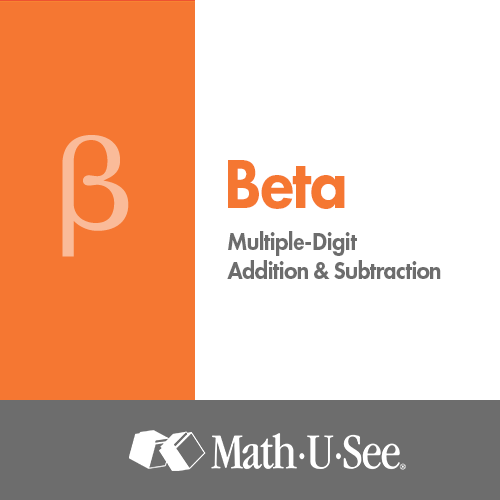
Description:
The Beta level applies students’ mastery of single-digit addition and subtraction to multiple-digit addition and subtraction by exploring the concept of place value, which is an important milestone for grasping any multiple-digit operation. Students will learn telling/writing time by hours/minutes, understanding adding/subtracting money, measuring/estimating length with inches, feet, centimeters, and meters, comparing numbers/lengths, expressing differences between numbers as inequalities, finding the perimeter of any polygon and representing and interpreting data in plots/graphs. Concepts presented will incorporate understanding place value and using it to add or subtract, fluently adding any combination of whole numbers, solving for an unknown addend, fluently subtracting any combination of whole numbers as well as solving abstract and real-world problems involving addition and subtraction.Includes:
BookShark Virtual Seat
Math-U-See Instruction Pack
Math-U-See Student Workbook
Integer Block Kit
Math-U-See Gamma
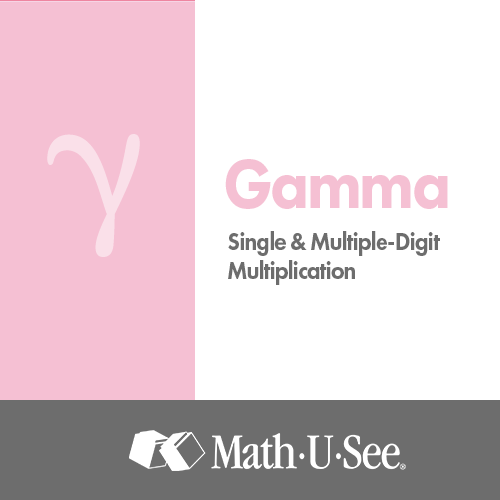
Description:
The Gamma level teaches single-digit facts and multiple-digit multiplication skills. Students learn skip counting as a precursor to multiplication, adding/subtracting time in hours/minutes, multiplying, adding/subtracting money and standard units of measure, representing, recording, and interpreting data, understanding of basic fractions as well as estimating and solving measurement problems. Concepts presented will incorporate using strategies based on place value and properties of operations to multiply, fluently multiplying any combination of whole numbers, solving for an unknown factor, solving abstract and real-world problems involving addition, subtraction, and multiplication, measuring and computing area and relating concepts of area to addition and multiplication.Includes:
BookShark Virtual Seat
Math-U-See Instruction Pack
Math-U-See Student Workbook
Integer Block Kit
Math-U-See Delta
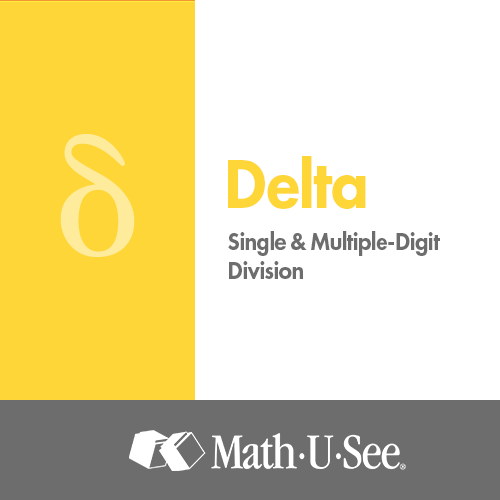
Description:
The Delta level presents division as the inverse of multiplication. Single-digit division facts are learned and the concepts of division and place value are applied when solving long division problems. Students learn reading and writing Roman numerals, dividing, multiplying, adding, and subtracting money and standard units of measure, understanding angle measure and geometric shapes including points, segments, rays, and lines, classifying shapes based on defining attributes as well as understanding and computing area and volume. Concepts presented incorporate Using strategies based on place value and properties of operations to divide, understanding division as solving for an unknown factor, fluently dividing any combination of whole numbers, solving abstract and real-world problems involving all four operations, interpreting remainders in short and long division and understanding fraction notation in light of division.Includes:
BookShark Virtual Seat
Math-U-See Instruction Pack
Math-U-See Student Workbook
Integer Block Kit
Math-U-See Epsilon
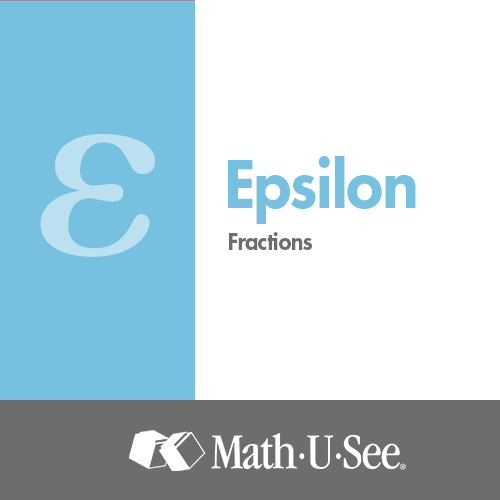
Description:
The Epsilon level covers operations with fractions. Fractions are presented in an intuitive way with visual explanations of equivalent fractions, common denominators, and fractions and numbers larger than 1. Fractions and operations are illustrated using Fraction Overlay manipulatives. Students learn using multiple strategies to recognize common factors, understanding grouping symbols and their effect on order of operations, interpreting and solving word problems, comparing/converting decimal fractions, finding the area and circumference of circles, classifying quadrilaterals, representing fractions and fractional measurements on line plots and number lines as well as using coordinates to represent ordered relationships. Concepts presented incorporate recognizing/generating equivalent fractions, understanding addition, subtraction, multiplication, and division of fractions and mixed numbers and fluently adding, subtracting, multiplying, and dividing fractions and mixed numbers.Includes:
BookShark Virtual Seat
Math-U-See Instruction Pack
Math-U-See Student Workbook
Integer Block Kit
Math-U-See Zeta

Description:
The Zeta level extends the student’s concept of place value to the right of the decimal point. Students learn to complete core operations with decimals. The connection between fractions and decimals is presented. Students learn understanding/simplifying exponents, understanding negative numbers and representing them on the coordinate plane, using properties of operations to simplify and evaluate algebraic expressions, interpreting and graphing relationships between dependent/independent variables, understanding of plane geometry & geometric symbols as well as using ratio reasoning to solve problems. Concepts presented incorporate expanding understanding of place value from positive powers of ten to include decimals, fluently adding, subtracting, multiplying, and dividing multiple digit decimals using place-value strategies, solving real-world problems with decimals and percentages and understanding the metric system and converting from one unit of measure to another.Includes:
BookShark Virtual Seat
Math-U-See Instruction Pack
Math-U-See Student Workbook
Integer Block Kit
Math-U-See Pre-Algebra

Description:
The Pre-Algebra level covers concepts that lay a foundation for Algebra. Students learn using the Pythagorean theorem to identify triangle attributes, transforming temperatures between Celsius and Fahrenheit, understanding and computing surface area/volume, adding/subtracting time using both 12-hour and military notation, adding/multiplying polynomials as well as identifying rational and irrational numbers. Concepts presented incorporate fluently adding, subtracting, multiplying, and dividing positive and negative numbers, understanding/simplifying exponents, using properties of operations, order of operations, and absolute value, expanding understanding of place value, evaluating radicals and identifying the least common multiple and greatest common factor.Includes:
BookShark Virtual Seat
Math-U-See Instruction Pack
Math-U-See Student Workbook
Integer Block Kit
Math-U-See Algebra 1
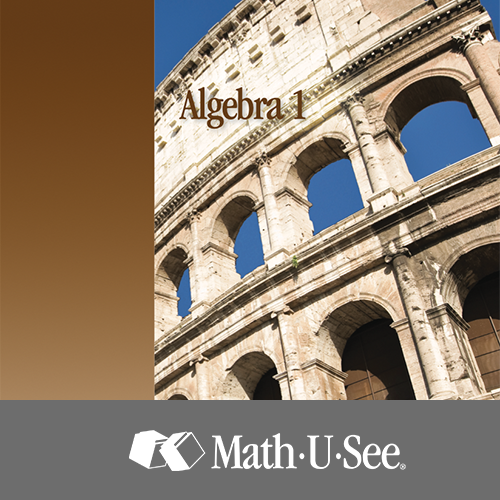
Description:
The Algebra 1 level covers Algebraic concepts. Students learn applying properties of arithmetic functions to algebra, adding, multiplying, and dividing polynomials, applying significant digits to computations with scientific notation, converting between base 10 and other bases, graphing conic sections as well as applying significant digits to computations with scientific notation. Concepts presented incorporate graphing linear equations/inequalities, describing linear equations in slope-intercept and standard form, solving systems of equations using graphing, substitution, and elimination, expanding understanding of exponents, solving basic quadratic equations with factoring and using unit multipliers to convert between units of measure.Includes:
BookShark Virtual Seat
Math-U-See Instruction Pack
Math-U-See Student Workbook
Integer Block Kit
Math-U-See Geometry
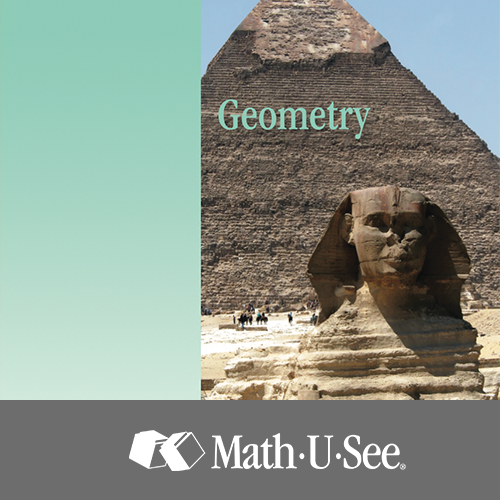
Description:
The Geometry level covers concepts pertaining to geometric shapes and properties. Students learn using a protractor to construct angles, using a compass to construct bisectors, constructing/identifying triangles, working with algebraic expressions containing radicals, completing geometric transformations within a Cartesian plane as well as understanding basic trigonometric functions. Concepts presented incorporate describing points, lines, rays, line segments, angles, and planes, calculating the measure of the interior and exterior angles of a regular polygon, understanding the geometry of a circle, sphere, and ellipse, understanding and computing volume and surface area of solids, using the Pythagorean theorem to identify triangle attributes and applying postulates, theorems, definitions, and properties to geometric proofs.Includes:
BookShark Virtual Seat
Math-U-See Instruction Pack
Math-U-See Student Workbook
Integer Block Kit
Math-U-See Algebra 2

Description:
The Algebra 2 level builds on the Algebraic concepts by adding the 2nd year’s elements. Students learn applying basic algebra to problems involving ratios/proportions, graphing inequalities, using the distance and midpoint formulas, solving equations with three variables, solving problems involving distance, rate, and time, as well as understanding vectors. Concepts presented incorporate simplifying multiple-degree rational expressions, working with imaginary and complex numbers, understanding/applying the binomial theorem, solving basic quadratic equations with factoring, applying analytic geometry to conic sections and solving simultaneous equations (linear and conic) using graphing, substitution, and elimination.Includes:
BookShark Virtual Seat
Math-U-See Instruction Pack
Math-U-See Student Workbook
Integer Block Kit
Math-U-See Pre-Calculus
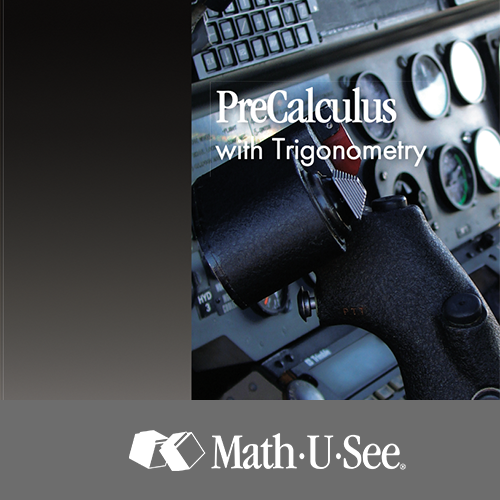
Description:
The PreCalculus level covers concepts that lay the foundation for calculus. Students learn understanding/applying the Laws of Sines and Cosines, understanding and applying the Sum, Difference, Double-Angle, and Half-Angle Identities, proving trigonometric identities, working with vectors and adding linear functions, understanding and working with logarithms as well as working with Euler's number and natural logarithms. Concepts presented incorporate understanding and working with trigonometric ratios, their reciprocals, and their inverses, working with trigonometric expressions and identities, understanding and working with polar coordinates and radian measure, graphing/analyzing trigonometric functions, understanding functions, limits, domain, and range and working with Arithmetic/Geometric Series and Sequences.Includes:
BookShark Virtual Seat
Math-U-See Instruction Pack
Math-U-See Student Workbook
Integer Block Kit
Math-U-See Calculus
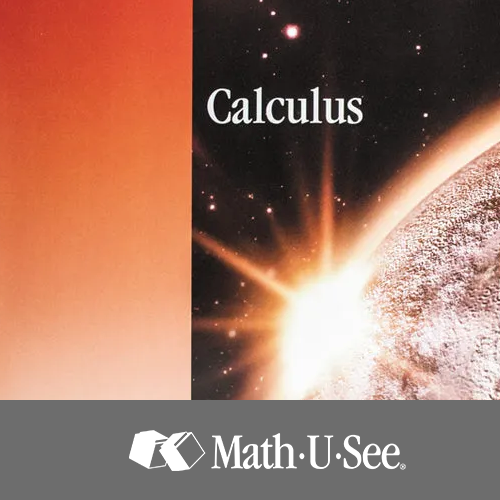
Description:
The Calculus level covers Calculus applications. Students learn applying the Chain Rule and the Mean Value Theorem, optimizing with calculus, understanding antiderivatives, working with integration formulas, solving differential equations as well as applying calculus to physics and economics. Concepts presented incorporate understanding limits and continuity, working with derivatives and derivative rules, using Implicit Differentiation, applying L’Hôpital’s Rule, working with definite and indefinite integrals and working with exponential/logarithmic functions and their derivatives.Includes:
BookShark Virtual Seat
Math-U-See Instruction Pack
Math-U-See Student Workbook
Integer Block Kit
RightStart Level A
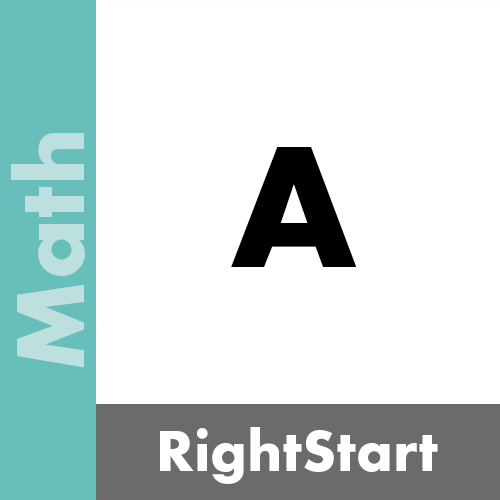
Description:
Rightstart’s Level A incorporates beginning level math lessons which will build a firm foundation with number sense through quantity recognition and visualization strategies using the AL Abacus. This level helps the student understand quantities based around 5s and 10s. Concepts covered include addition to 10, place value to the hundreds, and some basic geometry.Includes:
BookShark Virtual Seat
RightStart™ Mathematics Level A Second Edition Book Bundle (KM17)
RightStart Manipulative Set
RightStart Level B

Description:
Rightstart’s Level B continues to build on foundational math concepts and students learn addition facts to 18 along with mental strategies. Students also learn to add 4-digit numbers and 2-digit numbers mentally. Subtraction is delayed until addition is thoroughly understood. Place value is emphasized throughout. Other topics taught include geometry, measurement, money, clocks, and basic fractions.Includes:
BookShark Virtual Seat
RightStart™ Mathematics Level A Second Edition Book Bundle (1M17)
RightStart Manipulative Set
RightStart Level C

Description:
Rightstart’s Level C continues to build on known addition and subtraction facts, works with 4-digit addition and subtraction and 2-digit mental calculations and introduces multiplication and fractions. Other topics include area and perimeter, measurement, money, time, and basic fractions. They also work with drawing tools to explore geometric designs. Problem solving is emphasized. Card games are included in the lessons. Review lessons are included for students new to the RightStart™ program.Includes:
BookShark Virtual Seat
RightStart™ Mathematics Level A Second Edition Book Bundle (2M17)
RightStart Manipulative Set
RightStart Level D
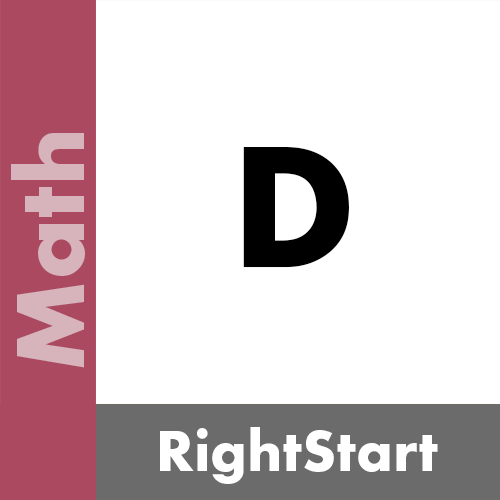
Description:
Rightstart’s Level D continues to build on the meaning and properties of multiplication and division, along with the basic facts. Other topics include multiplying a 4-digit number by a 1-digit number, rounding, numbers to millions, area and measurement in both the US customary and metric systems, fractions, and graphing. Students continue to work with geometry and angles using drawing tools. Problem solving with all four operations is emphasized. Daily card games are included in the lessons. Review lessons are included for students new to the RightStart™ program.Includes:
BookShark Virtual Seat
RightStart™ Mathematics Level A Second Edition Book Bundle (3M17)
RightStart Manipulative Set
RightStart Level E
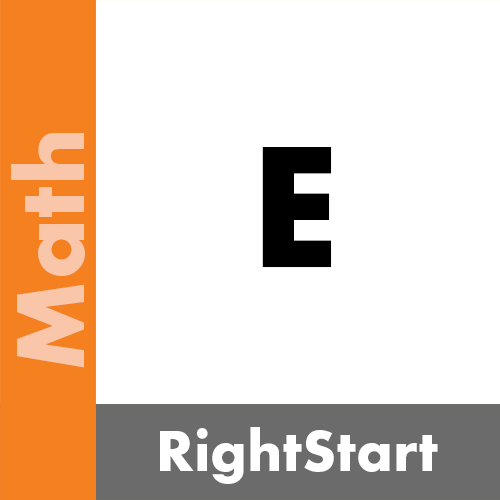
Description:
Rightstart’s Level E Lessons include multiplication of a multi-digit number by a 2-digit number, short division by a single digit, mixed and improper fraction addition and subtraction, factoring into primes, and introduces decimals and percentages. Multiple approaches to problem solving are also incorporated along with classifications of triangles and polygons, measurement in US customary and metric systems, area, angles, line plots, and solving simple algebraic equations. Daily card games are included in the lessons. Review lesson are included for students new to the RightStart™ program.Includes:
BookShark Virtual Seat
RightStart™ Mathematics Level A Second Edition Book Bundle (4M17)
RightStart Manipulative Set
RightStart Level F
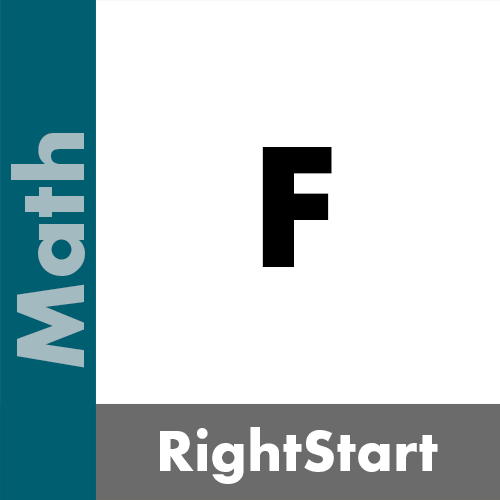
Description:
Rightstart’s Level F Lessons continue with multiplication and division of fractions and decimals. Percentages, exponents, factoring are included, along with multiplication and division facts. Long division, coordinate systems, graphing, negative numbers, and exponents will be taught along with probability. Geometry and measurement, as well as multi-step problem solving and an introduction to dimensional analysis are included. Daily card games are included in the lessons. Review lessons are included for children new to the RightStart™ program.Includes:
BookShark Virtual Seat
RightStart™ Mathematics Level A Second Edition Book Bundle (5M17)
RightStart Manipulative Set
RightStart Level G
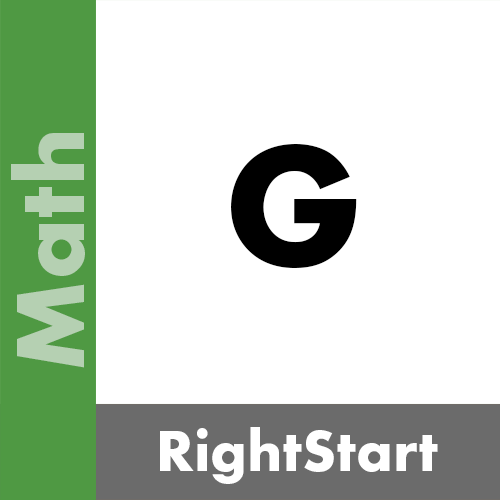
Description:
Rightstart’s Level G moves students through math incorporating hands-on strategies while visually representing geometric concepts. With a drawing board, T-square, triangles, compass, and goniometer, the student explores fractions, area, ratios, angles, Pythagorean theorem, and square roots. Circles, pi, arcs, along with reflections, rotations, and symmetry are taught all the while practicing arithmetic, fractions, and decimals. Some algebraic concepts are introduced. The history of mathematics is woven throughout the lessons. Daily card games are included in the lessons. Students work independently. No prior work with RightStart Math is necessary to complete this level.Includes:
BookShark Virtual Seat
RightStart™ Mathematics Level A Second Edition Book Bundle (6M17)
RightStart Manipulative Set
Saxon K
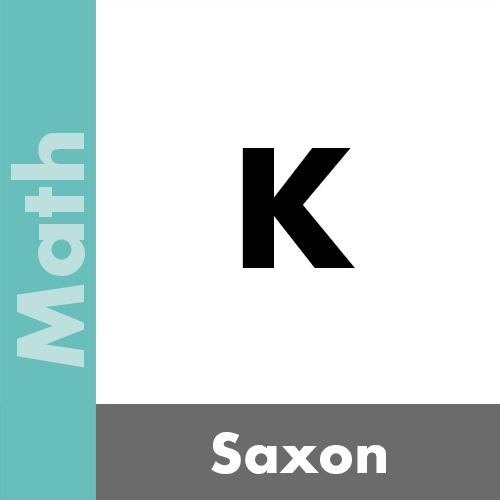
Description:
Saxon level K includes skills to, Count by 1’s, 5’s, and 10’s, Act out problems, Find answers for addition & subtraction stories using manipulatives, Compare and order numbers and Identify common shapes. There are two parts to the math program: The Meeting and The Lesson. Each week there are 3 lessons and on the other 2 days of the week you will repeat The Meeting from the day before (where review is emphasized by practicing the skills and concepts already introduced).Includes:
BookShark Virtual Seat
Saxon Math Homeschool Kit
Saxon Math Manipulatives Set
Saxon 1

Description:
Saxon level 1 includes skills to skip count by 1's, 2's, 5's, and 10's; compare and order numbers; identify ordinal position to tenth; identify a sorting rule; identify and extend patterns; solve routine and nonroutine problems; master all basic addition facts and most of the basic subtraction facts; add two-digit numbers without regrouping; picture and name fractions; measure using inches, feet, and centimeters; compare volume, mass, and area; tell time to the half hour; count pennies, nickels, dimes, and quarters; identify and draw polygons; identify geometric solids; tally; and create, read, and write observations from real graphs, pictographs, and bar graphs.Includes:
BookShark Virtual Seat
Saxon Math Homeschool Kit
Saxon Math Manipulatives Set
Saxon 2
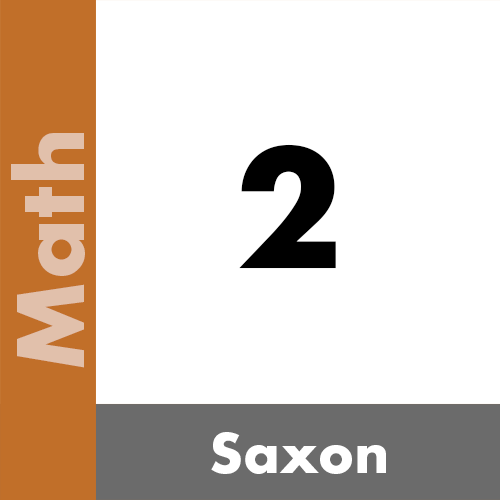
Description:
Saxon’s level 2 includes skills to skip count by 1's, 2's, 3's, 4's, 5's, 10's, 25's, and 100's; compare and order numbers; identify ordinal position to tenth; identify sorting and patterning rules; solve routine and nonroutine problems; master all basic addition and subtraction facts; master multiplication facts to 5; add and subtract two-digit numbers; picture and name fractions; measure to the nearest centimeter, foot, and half inch; compare volume; compare and measure mass; measure perimeter and area; tell time to five-minute intervals; count pennies, nickels, dimes, and quarters; identify geometric solids; identify lines of symmetry; identify angles; tally; and create, read, and write observations from real graphs, pictographs, bar graphs, Venn diagrams, and line graphs.Includes:
BookShark Virtual Seat
Saxon Math Homeschool Kit
Saxon Math Manipulatives Set
Saxon 3
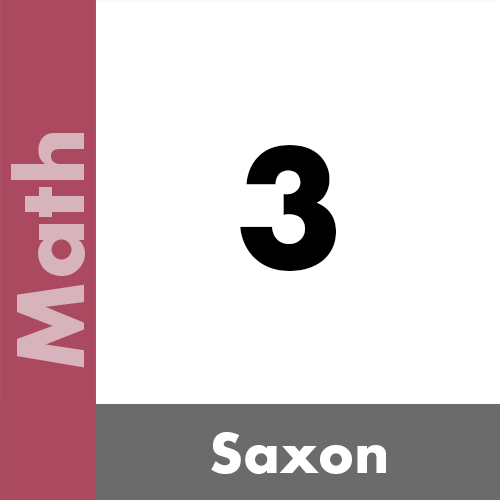
Description:
Saxon’s level 4 includes skills to skip count by whole numbers; compare and order numbers; identify place value; identify ordinal position to twentieth; identify and complete patterns; solve routine and nonroutine problems; master all basic addition, subtraction, multiplication, and division facts; add and subtract multi digit numbers; multiply a multidigit number by a single-digit number; divide by single-digit divisors; add positive and negative numbers; picture, name, and order fractions; add and subtract fractions with common denominators; measure to the nearest quarter inch, millimeter, foot, and yard; identify volume of standard containers; compare and measure mass; measure perimeter and area; tell time to the minute; determine elapsed time; count money; make change for a dollar; identify angles; identify lines of symmetry; identify function rules; graph ordered pairs on a coordinate graph; tally; and create, read, and write observations from real graphs, pictographs, bar graphs, Venn diagrams, and line graphs.Includes:
BookShark Virtual Seat
Saxon Math Homeschool Kit
Saxon Math Manipulatives Set
Saxon 5/4
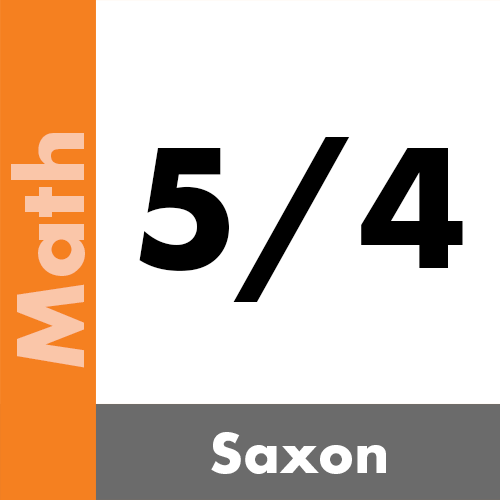
Description:
Saxon level 5/4 cover topics of addition (review), subtraction, multiplication (up to multiplying a three-digit number by a two-digit number), division (dividing by two-digit numbers), time, measurement, money, area, perimeter, fractions, mixed numbers, arithmetic algorithms, geometry, negative numbers, powers and roots, two-step word problems, decimals, averaging, estimation, patterns, sequences, statistics, probability, and Roman numerals. Saxon also uses Basic Fact Cards, a set of flashcards for working on addition, subtraction, multiplication, and division that are useful at this level.Includes:
BookShark Virtual Seat
Saxon Math Homeschool Kit
Saxon Math Manipulatives Set
Saxon 6/5

Description:
Saxon level 6/5 continues developing arithmetic skills through multiplication and division of fractions and decimals while reviewing and expanding concepts of place value, addition and subtraction, geometry, measurement, and probability. Powers and roots, prime and composite numbers, ratios, and order of operations are also taught. Extra math drills for each lesson are at the back of the book. Concepts presented at this level challenge students to work in more abstract ways.Includes:
BookShark Virtual Seat
Saxon Math Homeschool Kit
Saxon Math Manipulatives Set
Saxon 7/6
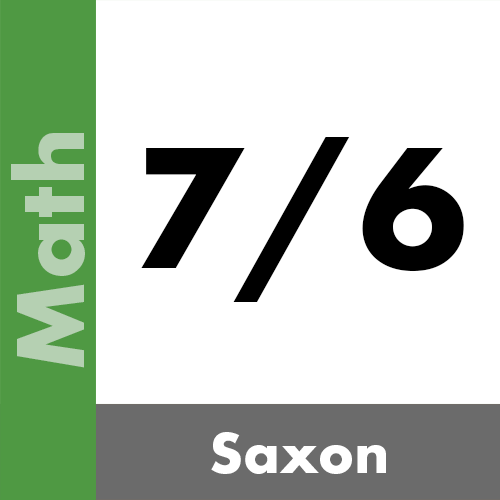
Description:
Saxon level 7/6 provides cumulative review and expansion upon topics covered in earlier levels. Among topics covered at this level are fractions, mixed numbers, decimals, percents, rounding, estimating, exponents, working with signed numbers, square roots, beginning algebraic expressions, volume, angles, circles, prime factorization, ratios, proportions, statistics, and probability. Especially notable are word problems that cause children to think of math concepts in a number of different ways to ensure understanding.Includes:
BookShark Virtual Seat
Saxon Math Homeschool Kit
Saxon Math Manipulatives Set
Saxon 8/7
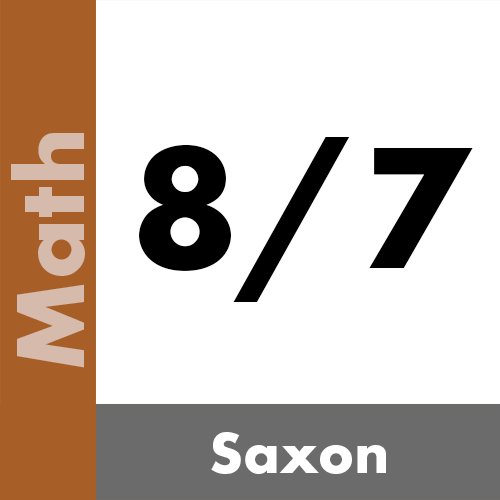
Description:
Saxon level 8/7 reviews material introduced in the prior levels and provides pre-algebra instruction. It covers word problems, scientific notation, statistics, probability, ratios, proportions, simplifying and balancing equations, factoring algebraic expressions, slope-intercept form, graphing linear inequalities, arcs, sectors, and the Pythagorean theorem.Includes:
BookShark Virtual Seat
Saxon Math Homeschool Kit
Saxon Math Manipulatives Set
Saxon Algebra 1/2
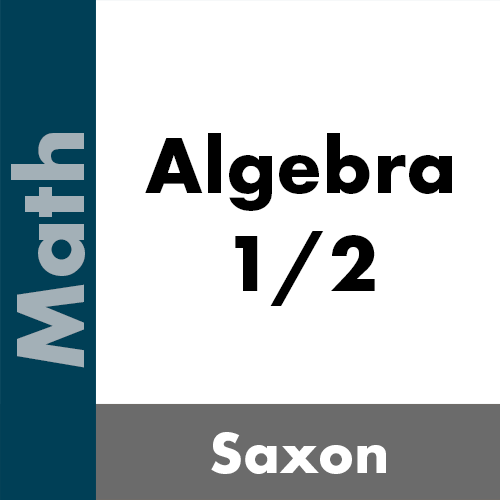
Description:
Saxon level Algebra ½ is a pre-algebra course offering plenty of review, a spiral learning process, thought-provoking word problems, and clear instruction that works for independent study. The level of difficulty rises sharply toward the end of the course. Among topics covered are fraction, decimal, and mixed number operations; scientific notation; exponents; radicals; algebraic expressions; solving equations with one variable; order of operations; ratios; geometry fundamentals; and graphing. Saxon Math has resisted the inclusion of calculator instruction even though most other texts for the pre-algebra level include it. While students can use calculators to solve problems when it is appropriate, they are not instructed to do so.Includes:
BookShark Virtual Seat
Saxon Math Homeschool Kit
Saxon Math Manipulatives Set
Saxon Algebra 1

Description:
Saxon level Algebra 1, third edition, coverage is comparable to that in other first-year algebra texts. However, Saxon Math teaches the use of a graphing calculator sparingly compared to many other courses. This curriculum incorporates a spiral method of presentation and leans heavily on review. Concepts covered include arithmetic and evaluation of expressions involving signed numbers, exponents, and roots, properties of real numbers, absolute value, equations and inequalities involving absolute value, scientific notation, unit conversions, solution of equations in one unknown, solution of simultaneous equations, the algebra of polynomials and rational expressions, word problems requiring algebra for the solution (such as uniform motion and coin problems), graphical solution of simultaneous equations, graphs of a variety of functions: linear, quadratic, cubic, square root, absolute value, translations and reflections of graphs, factoring, Pythagorean theorem, algebraic proofs, functional notation and functions, solution of quadratic equations by factoring, completing the square, and quadratic formula, direct and inverse variation, exponential growth, computation of the perimeter and area of two-dimensional regions, computation of the surface area and volume of a wide variety of geometric solids, statistics and probability.Includes:
BookShark Virtual Seat
Saxon Math Homeschool Kit
Saxon Math Manipulatives Set
Saxon Algebra 2
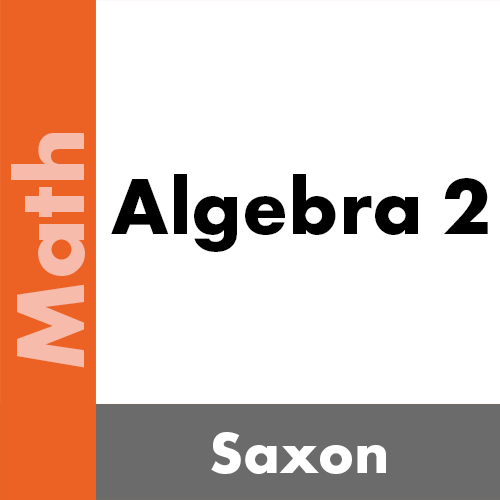
Description:
Saxon level Algebra 2, third edition, covers standard second-year algebra topics, although its inclusion of a significant amount of trigonometry is not a standard feature of all second-year courses. Students will need a scientific calculator for this course. Traditional second-year algebra topics, as well as a full semester of informal geometry, are included with both real-world, abstract and interdisciplinary applications. Topics include geometric functions like angles, perimeters, and proportional segments; negative exponents; quadratic equations; metric conversions; logarithms; and advanced factoring. Additional concepts cover uniform motion, chemistry-related problems, simultaneous equations with 2 and 3 variables, non-linear equations, geometry, right-triangle trigonometry, conversion from rectangular to polar coordinates, addition of vectors, complex numbers, and quadratic formulasIncludes:
BookShark Virtual Seat
Saxon Math Homeschool Kit
Saxon Math Manipulatives Set
Saxon Advanced Math
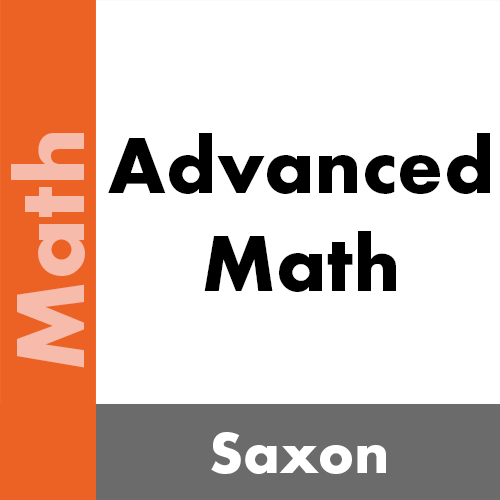
Description:
Saxon level advanced math provides an in-depth coverage of trigonometry, logarithms, analytic geometry, and upper-level algebraic concepts. It incorporates practice of intermediate algebraic concepts and trigonometry introduced in Algebra 2 and features new lessons on functions, matrices, statistics, and the graphing calculator. Additional concepts cover permutations, combinations, trigonometric/inverse functions, conic sections, matrices/determinants, binomial theorem, rational roots and Euclidean geometry.Includes:
BookShark Virtual Seat
Saxon Math Homeschool Kit
Saxon Math Manipulatives Set
Singapore Earlybird
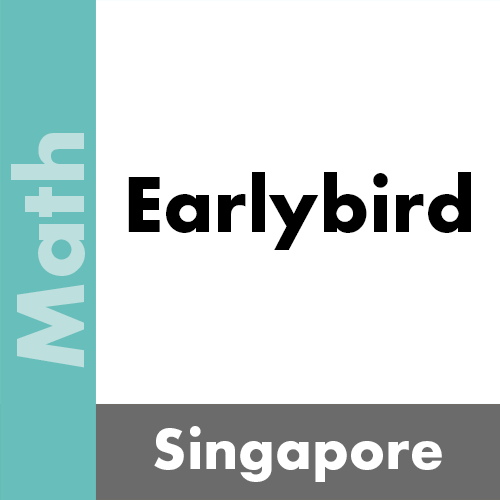
Description:
The Singapore level kindergarten math lays the foundation of math for early learnings and develops essential math concepts and basic reasoning skills in a fun and engaging way. Lessons are guided by focused learning objectives, exercises reinforce new knowledge, and reviews assess student learning. Each lesson is directed by a focused learning objective. Topics covered include Match and Sort, Numbers to 10, Order, Shapes, Patterns, Length/Size, Weight/Capacity and Comparing Sets.Includes:
Singapore Primary 1

Description:
Singapore’s level primary math 1 moves the student through foundational math topics that include Numbers 0 to 10, Number Bonds, Ordinal Numbers, counting/comparing/addition/subtraction with Numbers to 20, Shapes, comparing/measuring Length, money and graphs. Additional concepts incorporated are Adding Three Numbers, Adding Equal Groups, Making Multiplication Stories and Multiplication Within 40 as well as Sharing and Grouping with division, Halves and Fourths, telling/estimating time, Count past 100 and Estimation. Towards the end of this level, students will move into Addition and subtraction Within 100.Includes:
Singapore Primary 2

Description:
Singapore’s level primary math 2 moves a student into topics such as Counting/Comparing Numbers Within 1,000, Addition/subtraction Without/without Renaming, Measuring Length, adding/subtracting money, Halves, Fourths, and Third in addition to Multiplication/Division with 2’s, 3’s, 4’s, 5’s, 10’s. They also work on finding the Missing Number and Methods for Mental Addition/subtraction and Telling Time before/After the Hour. Students learn about tables and graphs (Picture Graphs, Bar Graphs, Line Plots) as well as geometry concepts of Flat/Curved Surfaces, Composite Figures, Angles and Shapes.Includes:
Singapore Primary 3
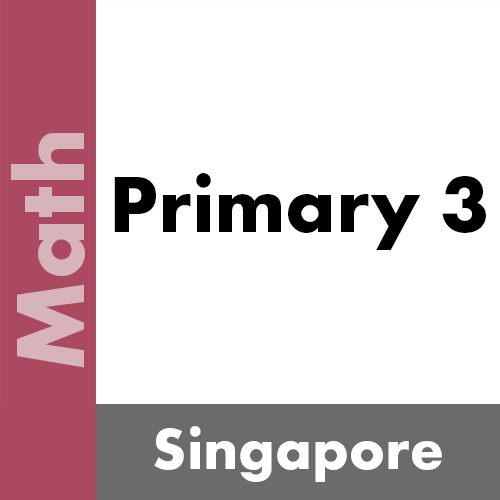
Description:
Singapore’s primary level 3 has students exploring numbers to 10,000 using Thousands, Hundreds, Tens, and Ones, Number Patterns and Rounding Numbers. Students advance their addition and subtraction skills by learning Mental Calculation, Sum/Difference,Two-step Word Problems and Adding/subtracting Ones, Tens, Hundreds, and Thousands. They also advance their multiplication and division skills by learning Multiplying/dividing Ones, Tens, and Hundreds, Quotient/Remainder and completing Word Problems. They work on mastering Multiplying and Dividing by 6, 7, 8 and 9. Additional concepts covered are length, Mass/Weight, capacity, money, fractions and time. Students also explore geometry concepts of Right Angles, Shapes as well as area/perimeter.Includes:
Singapore Primary 4

Description:
Singapore’s primary level 4 has students exploring numbers to 1,000,000 using Approximation Multiples, Factors and Order of Operations. Students continue working with the The Four Operations of Whole Numbers: Addition, Subtraction, Multiplication by 1 and 2 Digit Number as well as Division by Ones and Tens. Students learn about fractions, Improper Fractions, Equivalent Fractions and cover concepts of Adding/Subtracting/multiplying, dividing Fractions and adding/subtracting Mixed Numbers. They also move into adding, subtracting, multiplying and dividing decimals as well as cover geometry concepts including Points, Lines, Line Segments, Rays, Angles, symmetry and area/perimeter. They wrap up this level covering bar graphs, line plots and volume.Includes:
Singapore Primary 5

Description:
Singapore’s primary level 5 has students exploring whole numbers using Approximation/Estimation, Factors/Multiples, Multiplying/dividing by Tens, Hundreds, or Thousands, Order of Operations, Mental Calculation, Word Problems, and Multiplication/division by a 2-Digit Whole Numbers. Students continue to expand their understanding of Adding/Subtracting/multiplying, dividing Fractions and adding/subtracting Mixed Numbers. Additional concepts covered are perimeter, area and ratio as well as averages, graphs, rate, tessellations and volume.Includes:
Singapore Primary 6
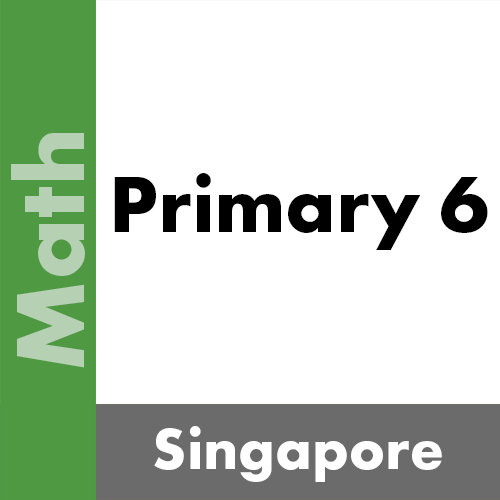
Description:
Singapore’s primary level 6 has students exploring more advanced math concepts using Algebraic Expressions, Solid Figures, Ratio with Fractions/Proportion, as well as percentages exploring Part of a Whole, Quantity as a Percentage of Another and Solving Percentage Problems by Unitary Method. Additional concepts covered are Radius/Diameter/Circumference/ area of a circle as well as finding unknown angles of triangles and 4-sided Figures. They work with more complex graphs and word problems.Includes:
Request A Consultation
Please reach out if you have any questions at all. We are here to help.
Maddie Suter
School Liaison & Support
720-215-6064
msuter@bookshark.com
BOOKSHARK VIRTUAL
8022 S GRANT WAY
LITTLETON, CO 80122
